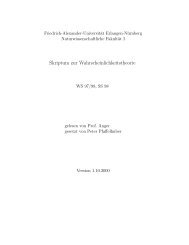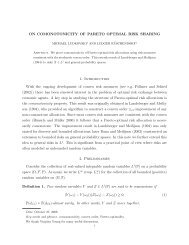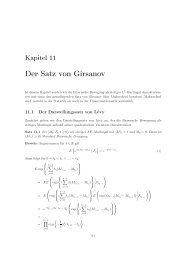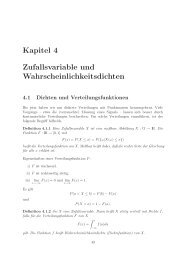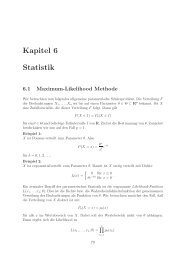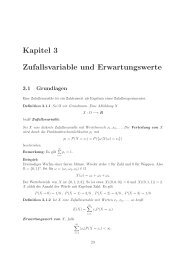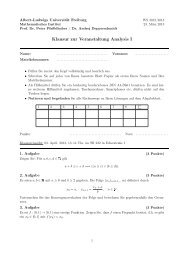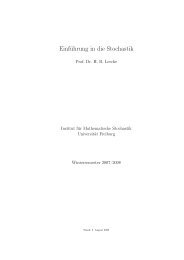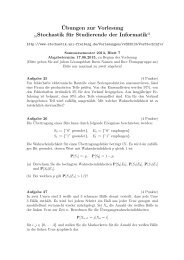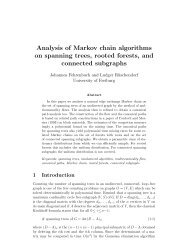On the Internal Path Length of dâdimensional Quad Trees
On the Internal Path Length of dâdimensional Quad Trees
On the Internal Path Length of dâdimensional Quad Trees
You also want an ePaper? Increase the reach of your titles
YUMPU automatically turns print PDFs into web optimized ePapers that Google loves.
transform; X has exponential tails. It’s moments are determined (in principle)<br />
by a recursion. We calculate <strong>the</strong> second moment <strong>of</strong> X which gives <strong>the</strong><br />
asymptotic variance v d <strong>of</strong> Y n .<br />
For <strong>the</strong> pro<strong>of</strong> we extend <strong>the</strong> contraction method introduced by Rösler [16]<br />
for <strong>the</strong> analysis <strong>of</strong> Quicksort to <strong>the</strong> analysis <strong>of</strong> <strong>the</strong> internal path length <strong>of</strong> quad<br />
trees. It seems difficult to extend <strong>the</strong> martingale method which was used in<br />
Régnier [15] for <strong>the</strong> analysis <strong>of</strong> Quicksort. The contraction method has been<br />
fur<strong>the</strong>r developed independently in Rösler [17] and Rachev and Rüschendorf<br />
[14]. The essential ingredient our pro<strong>of</strong> uses is <strong>the</strong> recursion satisfied by Y n<br />
plus <strong>the</strong> second order asymptotics <strong>of</strong> <strong>the</strong> first moments as in (3). We do<br />
not need a priori asymptotics <strong>of</strong> <strong>the</strong> second moments. The explanation <strong>of</strong><br />
this behavior from <strong>the</strong> point <strong>of</strong> view <strong>of</strong> <strong>the</strong> contraction method is <strong>the</strong> fact,<br />
that <strong>the</strong> limiting operator T <strong>of</strong> <strong>the</strong> recursion <strong>of</strong> <strong>the</strong> Y n (which exists by <strong>the</strong><br />
asymptotics <strong>of</strong> IEY n !) has contraction properties w.r.t. <strong>the</strong> l 2 –metric. This<br />
implies that only control <strong>of</strong> <strong>the</strong> first moments is necessary as is well known<br />
from <strong>the</strong> <strong>the</strong>ory <strong>of</strong> probability metrics.<br />
In <strong>the</strong> final part <strong>of</strong> <strong>the</strong> paper we consider general split tree models as<br />
introduced in Devroye [4]. The limit <strong>the</strong>orem for <strong>the</strong> quad trees extends to<br />
this class <strong>of</strong> split trees if <strong>the</strong> first moment <strong>of</strong> <strong>the</strong> path length has a similar<br />
expansion <strong>of</strong> <strong>the</strong> form cn ln n + dn + o(n), as in <strong>the</strong> case <strong>of</strong> quad trees. This<br />
method thus yields a limit <strong>the</strong>orem also for m-ary trees.<br />
The authors would like to thank P. Flajolet for an essential hint to <strong>the</strong><br />
limiting distribution.<br />
2 <strong>Quad</strong> trees and <strong>the</strong> internal path length<br />
A quad tree is constructed similarly to a binary search tree. Given a data<br />
vector (p (1) , . . . , p (n) ), p (i) ∈ IR d , <strong>the</strong> points p (i) build up successively <strong>the</strong><br />
quad tree. Without loss <strong>of</strong> generality p (i) ∈ [0, 1] d . Then <strong>the</strong> i–th data<br />
point p (i) ∈ [0, 1] d partitions <strong>the</strong> rectangle it belongs to into 2 d quadrants<br />
and thus creates 2 d new rectangles (quadrants) each having p (i) as a vertex.<br />
See Flajolet, Gonnet, Puech and Robson [8] or Mahmoud [12] for details <strong>of</strong><br />
this contruction. We use a special ordering for <strong>the</strong> insertion <strong>of</strong> a new key<br />
p ∈ [0, 1] d as in Flajolet et al. [8]. When comparing p with a node w ∈ [0, 1] d<br />
<strong>of</strong> <strong>the</strong> quad tree we determine <strong>the</strong> number <strong>of</strong> <strong>the</strong> subtree in which p is inserted<br />
in <strong>the</strong> following way: The node w partitions <strong>the</strong> quadrant it belongs to into<br />
3




